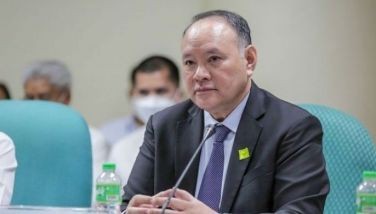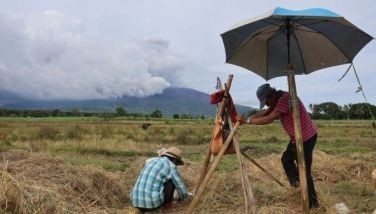PMA goes retro, sheds old uniform
October 24, 2004 | 12:00am
Cadets of the Philippine Military Academy (PMA) will soon be part of a fashion revolution.
The cadets will soon shed off their old "West Point inspired" uniforms and jump into the rayadillo, the uniform worn by their forefathers during the Philippine revolution against Spain.
By next year, the academy’s more than 1,000 cadets will be wearing the rayadillo and the hot full dress uniform will be a thing of the past.
Commandant of Cadets Brig. Gen. Cardoso Luna said the change in uniforms is part of the PMA’s general makeover.
The PMA, formally established in 1936, traces its origins to the foundation on Oct. 25, 1898 of the Academia Militar.
The PMA commandant has another reason to be excited by the change. Luna is descended from the designer of the rayadillo, painter and revolutionary Juan Luna.
The painter’s brother, then Secretary of War Gen. Antonio Luna, wanted a design that would make Filipino soldiers stand out from their battlefield opponents.
"During the Philippine revolution and the Philippine—American War, the rayadillo uniform was truly unique," Luna said. "It epitomized (the) patriotic passion for emancipation from centuries of subjugation."
The rayadillo was the uniform worn by the first regular army established under the Tejeros Convention.
"It was the first uniform of cadets in Malolos, Bulacan," Luna said.
Luna said it was ironic that the PMA should "adopt the pride and identity of one of our former enemies."
But outgoing AFP chief Gen. Narciso Abaya said the idea for a nationalistic cadet uniform goes back to the academy’s earliest years. The proposed design is derived from the artistic work of then cadet Washington Sagun, a distinguished graduate of the PMA Class of 1940.
The desire to be nationalistic isn’t the only reason to pick the revolutionary design over the Western copy, Luna insists.
"The wool which is the dominant material for the full-dress uniform reflects impractical colonialism. The cloth itself is seldom used in tropical Philippines," he said.
Luna said the indigenous origin of rayadillo could be seen in its design and material.
He said the new design made a favorable impression on the company of cadets that tried it out.
"They like it," he said.
Luna said the cadets are happier with the rayadillo because they find it more "comfortable."
"Since the materials used are made of cotton fibers and are light-colored, the uniform is essentially comfortable to wear," he said.
Luna said the full dress uniform is not suitable for parades and other functions outside the cold environs of Baguio.
He said an inner lining for the uniform is needed because the wool tends to cause allergic reactions on the skin. The lining adds to the discomfort of the uniform by making it heavier and preventing ventilation.
Economics could also be a factor in the shift to the rayadillo. While not admitting the change is part of the government’s austerity program, Luna said a rayadillo uniform would cost almost half the full dress uniform.
Luna said the price of woolen fabric used in the full dress uniform is P600 a yard, double the price of the fabric used in the rayadillo at P300.
The cadets will soon shed off their old "West Point inspired" uniforms and jump into the rayadillo, the uniform worn by their forefathers during the Philippine revolution against Spain.
By next year, the academy’s more than 1,000 cadets will be wearing the rayadillo and the hot full dress uniform will be a thing of the past.
Commandant of Cadets Brig. Gen. Cardoso Luna said the change in uniforms is part of the PMA’s general makeover.
The PMA, formally established in 1936, traces its origins to the foundation on Oct. 25, 1898 of the Academia Militar.
The PMA commandant has another reason to be excited by the change. Luna is descended from the designer of the rayadillo, painter and revolutionary Juan Luna.
The painter’s brother, then Secretary of War Gen. Antonio Luna, wanted a design that would make Filipino soldiers stand out from their battlefield opponents.
"During the Philippine revolution and the Philippine—American War, the rayadillo uniform was truly unique," Luna said. "It epitomized (the) patriotic passion for emancipation from centuries of subjugation."
The rayadillo was the uniform worn by the first regular army established under the Tejeros Convention.
"It was the first uniform of cadets in Malolos, Bulacan," Luna said.
Luna said it was ironic that the PMA should "adopt the pride and identity of one of our former enemies."
But outgoing AFP chief Gen. Narciso Abaya said the idea for a nationalistic cadet uniform goes back to the academy’s earliest years. The proposed design is derived from the artistic work of then cadet Washington Sagun, a distinguished graduate of the PMA Class of 1940.
The desire to be nationalistic isn’t the only reason to pick the revolutionary design over the Western copy, Luna insists.
"The wool which is the dominant material for the full-dress uniform reflects impractical colonialism. The cloth itself is seldom used in tropical Philippines," he said.
Luna said the indigenous origin of rayadillo could be seen in its design and material.
He said the new design made a favorable impression on the company of cadets that tried it out.
"They like it," he said.
Luna said the cadets are happier with the rayadillo because they find it more "comfortable."
"Since the materials used are made of cotton fibers and are light-colored, the uniform is essentially comfortable to wear," he said.
Luna said the full dress uniform is not suitable for parades and other functions outside the cold environs of Baguio.
He said an inner lining for the uniform is needed because the wool tends to cause allergic reactions on the skin. The lining adds to the discomfort of the uniform by making it heavier and preventing ventilation.
Economics could also be a factor in the shift to the rayadillo. While not admitting the change is part of the government’s austerity program, Luna said a rayadillo uniform would cost almost half the full dress uniform.
Luna said the price of woolen fabric used in the full dress uniform is P600 a yard, double the price of the fabric used in the rayadillo at P300.
BrandSpace Articles
<
>
- Latest
- Trending
Trending
Latest
Trending
Latest
Recommended



























